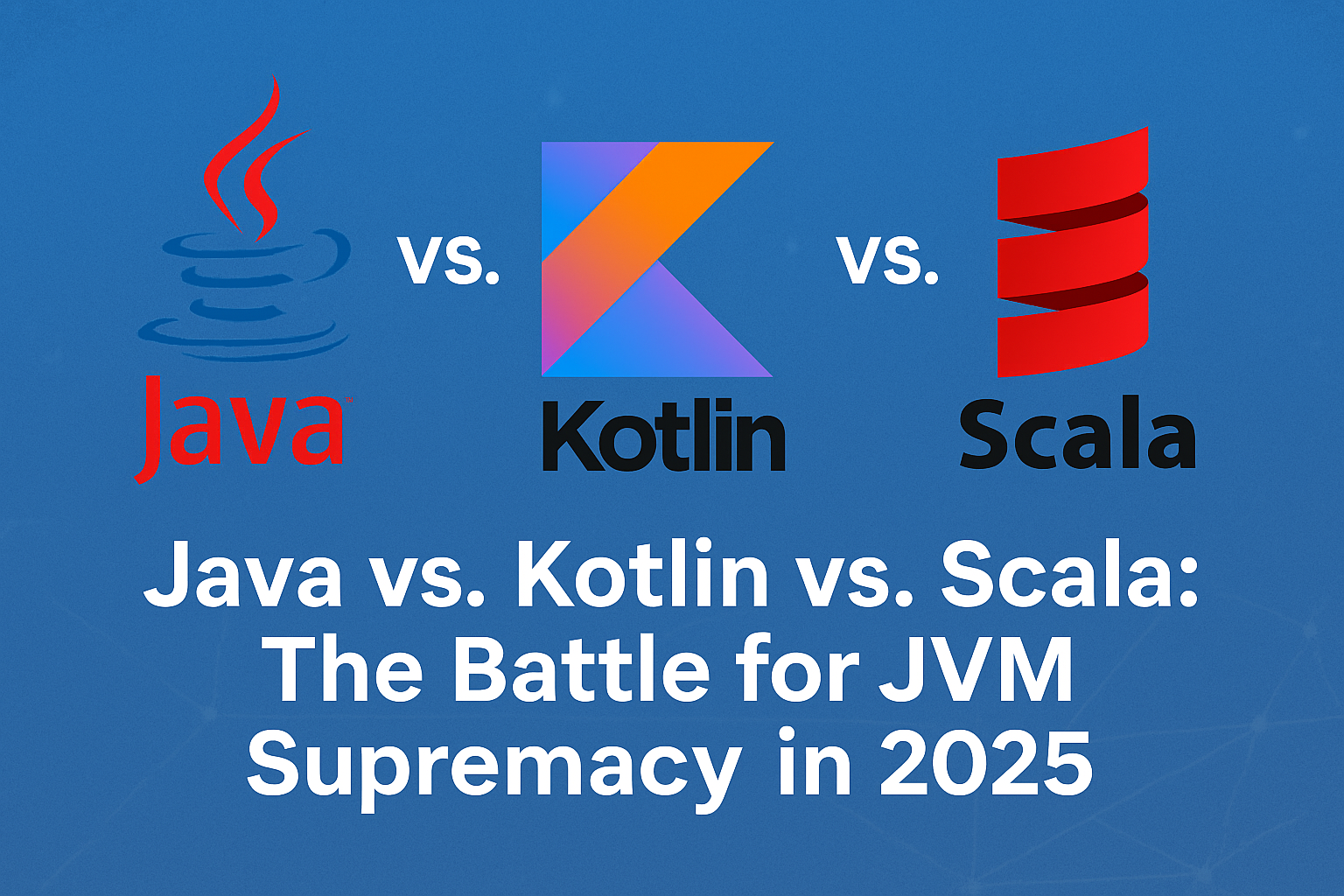Java vs. Kotlin vs. Scala: The Battle for JVM Supremacy in 2025. In the ever-evolving world of software development, the battle among programming languages continues. Java, Kotlin, and Scala are three powerful languages in the JVM (Java Virtual Machine) ecosystem, each with its own strengths and weaknesses. As we move into 2025, developers, businesses, and tech enthusiasts are keen to understand which of these languages will dominate the market. This blog provides an in-depth comparison of Java, Kotlin, and Scala, analyzing their strengths, use cases, and future trends.
Table of Contents
1. Java: The Legacy Powerhouse
Strengths of Java
Java has been the backbone of enterprise applications, Android development, and large-scale systems for over two decades. It remains one of the most widely used programming languages due to:
- Platform Independence: Write once, run anywhere (WORA) philosophy.
- Strong Community Support: Millions of developers worldwide contribute to Java’s continuous improvement.
- Robust Security: Java offers powerful security features, making it ideal for banking and enterprise applications.
- Scalability: Used in massive systems like Amazon, LinkedIn, and Netflix.
Recent Improvements (Java 22 and Beyond)
Java has evolved significantly, introducing features like:
- Project Loom: Lightweight virtual threads for high-performance concurrency.
- Pattern Matching Enhancements: More readable and efficient code structures.
- Foreign Function & Memory API (FFM API): Improved integration with native code.
- Improved Garbage Collection: Enhanced memory management and performance.
Challenges with Java
- Verbose Syntax: Compared to Kotlin and Scala, Java code tends to be longer and more complex.
- Slower Adoption of New Features: New features take time to stabilize.
- Less Functional Programming Support: While Java has introduced functional programming features, it still lags behind Kotlin and Scala.
Learn more about Java 22 improvements
2. Kotlin: The Modern Java Alternative
Strengths of Kotlin
Kotlin, developed by JetBrains, has gained immense popularity, particularly in Android development and backend services. Some of its key advantages include:
- Concise and Expressive: Requires fewer lines of code than Java.
- Interoperability with Java: Seamlessly integrates with existing Java codebases.
- Null Safety: Reduces runtime errors caused by
NullPointerExceptions. - Coroutines: Provides better concurrency support with lightweight threads.
- Official Language for Android: Preferred by Google for Android development.
Recent Improvements in Kotlin
- Kotlin Multiplatform: Expanding beyond Android, Kotlin is now used for cross-platform development.
- Performance Enhancements: Faster compilation and runtime optimizations.
- Better Native and Web Support: Kotlin/Native and Kotlin/JS are improving significantly.
Challenges with Kotlin
- Slower Compilation Speeds: Compared to Java in some cases.
- Smaller Community: Growing but still smaller than Java.
- Limited Adoption in Large Enterprises: Java remains dominant in large-scale applications.
Check out Kotlin’s latest advancements
3. Scala: The Functional Programming King
Strengths of Scala
Scala, designed to be a blend of object-oriented and functional programming, is widely used in data science, big data processing, and high-performance applications.
- Powerful Functional Programming Features: Supports immutability, higher-order functions, and monads.
- Strong Type System: Prevents many runtime errors.
- Concise Code: Less boilerplate compared to Java.
- Great for Big Data: Used extensively with Apache Spark.
Recent Improvements in Scala
- Scala 3 Enhancements: Simplified syntax and improved metaprogramming.
- Performance Optimizations: Faster compilation and execution.
- Better Interoperability with Java: Easier integration with Java libraries.
Challenges with Scala
- Complex Learning Curve: Harder for beginners compared to Java and Kotlin.
- Longer Compilation Times: More complex features lead to slower builds.
- Less Enterprise Adoption: Mainly used in niche areas like data science and finance.
4. Which Language Will Dominate in 2025?
Market Trends & Adoption
- Java will remain dominant in enterprise applications, cloud computing, and large-scale systems.
- Kotlin is rapidly growing, especially in Android development and backend services.
- Scala will continue to thrive in data science, AI, and big data but may struggle to expand beyond niche domains.
Which One Should You Choose?
| Use Case | Recommended Language |
|---|---|
| Enterprise Applications | Java |
| Android Development | Kotlin |
| Web & Backend Development | Kotlin / Java |
| Big Data & AI | Scala |
| Functional Programming | Scala |
| Cross-Platform Development | Kotlin |
Final Thoughts
Java, Kotlin, and Scala each have their strengths and weaknesses. Java remains the industry standard for enterprise applications, Kotlin is the go-to for Android and modern web development, while Scala excels in data-driven applications.
While no single language will “dominate” in 2025, we can expect Java to retain its stronghold, Kotlin to continue rising, and Scala to maintain its niche in data science and high-performance computing. The best language for you depends on your project’s requirements and long-term goals.
Which language do you think will lead in 2025? Let’s discuss in the comments below! 🚀
Find more Java content at: https://allinsightlab.com/category/software-development

